|
In the last few years the running of rat agility and other
fun events has become more and more common at our rat shows. This shows a
completely new kind of skill rat owners can do with their rats and with our rats
being very intelligent little beasts; they can sometimes be very easy to train
to do agility and obedience tests.
A few of us have worked on some ideas for scoring agility and
obedience type events and to create the guidelines we took onboard how the
Swedish Rat Society run their agility events and modified their guidelines to
suit ourselves. Below are our draft ideas with guidelines as to the kinds of
points that should be awarded.
We recently ran a 4 event agility and obedience competition
at the Taunton show and it seemed to go down very well with the exhibitors. We
created the guidelines for this show and below the agility guidelines are the
other suggested events and guidelines. From the experience of running these
events, the main things identified were a need to ensure the judge(s) understand
what they are looking for in the guidelines, so this may identify a need to have
trained agility/obedience judges in the future. I think all the exhibitors went
away positive, thinking they need to spend more time with their rats training
them for this type of event!
Agility Obstacles
All of the below were made with my own fair hands and I am by
no means a DIY expert - usually far more of a 'get someone else to do it'
instead! I used MDF and doweling rods and long planks of wood from a DIY
superstore. I used nails for most, although wood glue was sturdy enough (I
lacked patience and didn't want to wait for glue to dry!), ensured I filed and
sanded down all edges and ends so there can be no injury to rat or handler and I
found some wonderful purple paint to make the fences really stand out! Quinn,
Sierra and Zephyrus kindly modelled the obstacles for me - the nice thing about
bucks, you can put them in one place and they will stay there for photos, but it
is rare for a buck to make a good agility rat!
The show jump
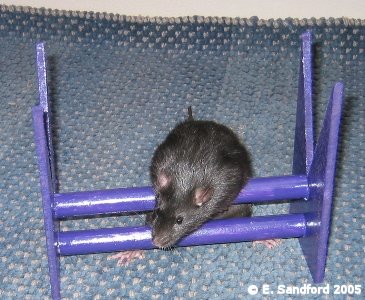
Very simple fence to create - I actually used the cut outs I
had left over from another fence for the end pieces which made them a bit more
original, but basically take two equal sized pieces of MDF for the ends and two
equal length bits of doweling for the bars and nail or glue them together.
It works best to ensure that the gaps between the bars and
the table are not big enough for rats to squeeze through or under.
This makes an ideal starting fence for the course as it is
really simple.

The fence with the hole in it!
I used a tuna can as the template for the hole and used a
small handsaw that has a pointed end for making holes in wood and followed my
line on a square of MDF. I filed any sharp edges down and tested it with my
largest buck to ensure most rats would get through ok. I then cut two ends and a
base from the MDF and tacked them together as well as gluing them to make it
easier to hold them together.
This one makes an ideal finishing fence as something nice and
simple to end the course.
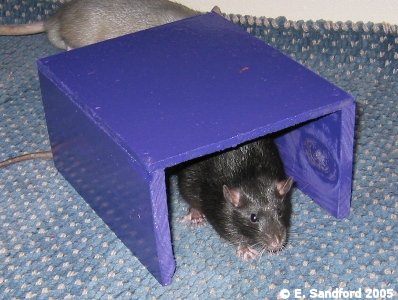
The Tunnel
Another fairly simple obstacle. I cut down two lengths of
wood and nailed another square of MDF to make the bridge.
This obstacle has actually proved to have quite a few uses
aside from being a tunnel. It can be used as a table for the staying competition
and turning it over, it can be used as a starting block for the coming when
called competition.

The Long Jump
Very simple fence to make - take one length of wood and two
lumps of wood and nail them securely together. The gap is 6 inches in this case.
I used bits of fence post for my blocks.
Obstacle can also be turned over to make a bridge to cross or
go under.
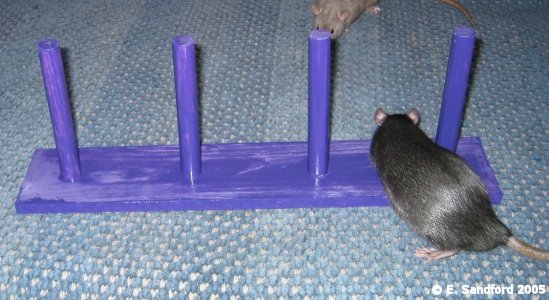
Weaving poles
I cut the doweling rods into 6 inch lengths and nailed them 5
inches apart to create a weave.
Another version of the Weaving
Poles
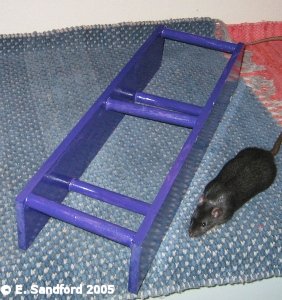

I also created a more complex version of this which could be
used in several angles - it was a bit of a prototype and in hindsight I would
change the offset of the poles. This can be used either flat as an
under/over or as weaving poles.

The Water Fence
This double dog bowl makes a great obstacle, although my rats
seem to be more interested in drinking the water than climbing over it. The
usual way we use this obstacle is to get them to cross the centre ridge.
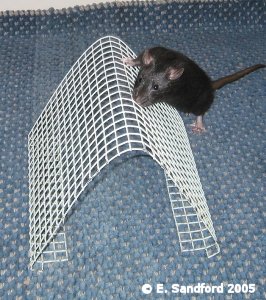
The Derby Bank!
This is part of a base mesh from a critter cage bent to make
a ramp. It is very important to file down any sharp ends on this obstacle.

The Seesaw
Very simple obstacle to make. Just take a piece of doweling
and securely glue it to the middle of a plank - mine is 18 inches long, which
seems to balance nicely.

The Ramp
This obstacle was my greatest challenge and took the longest
to create. I cut two planks and then had to angle the ends to join them and also
allow the base ends to sit flat on the table. I added side bars to make the
fence more solid and using square doweling for the steps on the ramps.
With practice, it would be ideal to have rats touching below
both bottom steps as would be expected in dog agility.

The Table
Similarly made to the long jump - nail lump of wood to a
square of MDF to make a sturdy little table for use either within the obstacle
course to make them stop on it for a few seconds, or just as the table for the
staying obedience test.
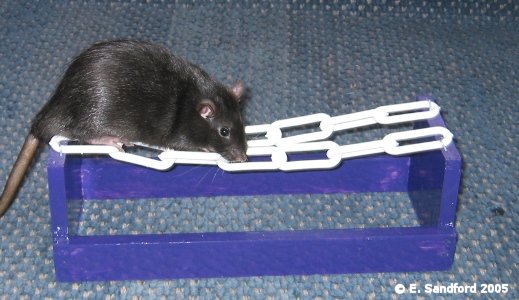
The Chain Walk
This obstacle was an experiment really, but it has proved to
be a real hit with the rats with most completing it quite easily. The gap
between the chains is about an inch and they are quite taunt, so the rat doesn't
slip off and fall into the middle.
Made fairly simply by using two bits from the planks of wood
for the ends and 2inch wide for the side ones. The chain is nailed on with fence
staples and is plastic so easy enough to clean down.
This obstacle could also be used as a jump by turning it the
other way on the course.
To Summarise...
What you tend to find once you have made a few obstacles is
that you look at many things around you in a totally different light - kids
toys, household stuff and places like DIY stores, garden centres, IKEA, etc. are
seen with a whole new light...
Key
Guidance For Agility
-
Any
obstacles and items used for these events must be easy to wipe down with
antibacterial spray/cloth between rats.
-
The table
should be wiped down between rats to discourage rats from stopping to take
in other rats scents or markings on the table and obstacles.
-
When
making obstacles bear in mind that ropes and material cannot be de-scented
or cleaned down.
-
Judges
should make it clear to exhibitors at the start of each event, how they are
planning on scoring the points available.
Obstacle
course
Scenario

6-8 varying obstacles arranged as a
course for rats to follow a route guided by their handler. When thinking
obstacles, the kind of things we are looking at are climb over, climb through,
balance, weave, water, ramps, tubes, etc. as above. Number of obstacles and
shape of course will depend on facilities available. Time allowed for 6-8
obstacles should be 2 minutes maximum and points awarded for speed, number of
obstacles completed and style/finesse. Number of obstacles and time allowed may
vary from show to show, dependant on what is available and time allowed to run
the event.
Judging Guidelines
-
The level of contact between the
partnership, the finesse and style in which the obstacles are tackled,
whether the rat is a doe or a buck (in general does are more agile and
faster, so this should be taken into account when judging – a buck who has
taken longer to complete the course, but has obviously ‘thought’ his way
through the obstacles should be prioritised over a doe who has started
‘running’ and the obstacles are incidental!). Time taken is part of the
event, but contact and style should be prioritised over time.
-
The competition should take place on
unfamiliar obstacle course – i.e. any practising prior to the event starting
should not be done on the entire course and route used for the main event.
-
The course to remain the same
throughout the competition for all participants.
-
A partnership may only compete once
on the day of the competition, but a handler can enter as many different
rats as they wish.
-
The handler may touch the rat, pat,
stroke and use gentle encouragement, but may not lift the rat from the
competition table or use another rat or handler as assistance. Rats should
not be ‘driven’ around the course like a toy car.
-
A partnership that completes the
course without fault within the time allowed should be awarded a clear round
card.
-
Style/finesse points are awarded
during the obstacle course. Examples of criteria for these points are:
patience, empathy, ingenuity, clear signals and guidance, obedience,
curiosity, intelligence, overcoming fear, willingness to co-operate,
telepathy, trust, etc.
-
After describing how the obstacle
course is to be completed to all competitors, the judge should not give
advice to entrants while they are competing. Any tips and comments should be
given after the completion of the competition.
-
The order of obstacles and the
direction in which the fences are to be completed should be decided on the
day by the judge. Clockwise or straight line is easiest orientation.
Anti-clockwise, figure-8, zigzag or complex track is more difficult.
-
Special awards may be given for
handlers/rats showing ingenuity or inventive methods or at the judge’s
discretion. (judges favourite, consolation prizes, etc.)

Scoring Guidelines
Time: -
max of 5 points available
5 points for completing course in
quarter of time allowed – i.e. usually 30 seconds.
4 points for completing course in half the allowed time – i.e. usually 1 minute.
3 points for completing course in within maximum allowed time – i.e. usually 2
minutes.
1-2 points based on how far around the course the rat got in the time allowed.
Obstacles: -
5 points available on obstacles completed roughly divided between number of
obstacles on the course. This would be at the judges discretion and should be
made clear how the points are accumulated before the event starts but for
example if 8 obstacles are used, could be half point per obstacle and a bonus
point for completion within allowed time.
Interaction, style, finesse, obedience:
- maximum of 10 points
available based upon the above guidelines. Roughly speaking, these are the kind
of level of points expected to be given.
10 points – rat that clearly understands
it’s handler’s signals and follows guidance around the course confidently and
well within the allowed time. i.e. perfection and very unlikely to ever be
awarded!
8-9 points – rat that has good understanding of it’s handler’s signals and
follows guidance around the course within the allowed time with limited touching
from the handler.
6-7 points – rat that responds to it’s handler’s signals and follows guidance
around the course within the allowed time with more prompting and touching from
the handler, but without being ‘driven’ around the course.
4-5 points – rat that gives some response to it’s handler’s signals and follows
guidance around the course with more prompting and touching from the handler,
but without being ‘driven’ around the course.
2-3 points – rat that gives limited response to it’s handler’s signals and
partially follows guidance around the course with quite a lot of prompting and
touching from the handler, but without being ‘driven’ around the course.
0-1 point – rat that barely responds or shows no response to it’s handler’s
signals and struggles to complete any part of the course.
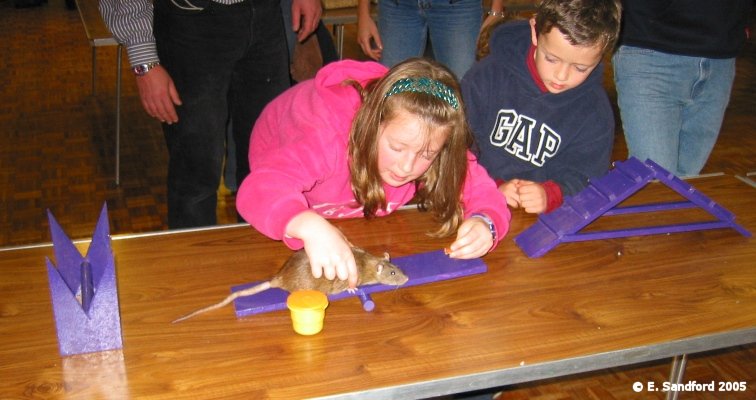
Other types
of Events
Curiosity
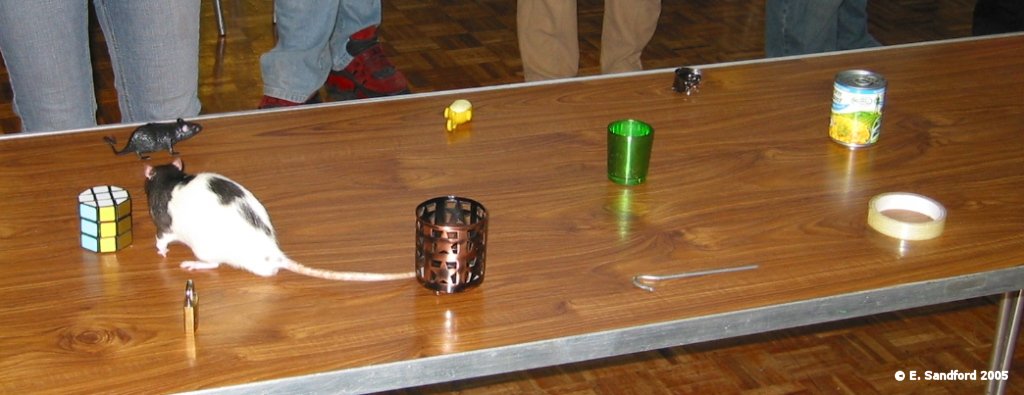
Curiosity is testing the rat’s inbuilt
curiosity of their surroundings. It is an event where the handler really has no
input and it’s down to the rat. Most rats do quite well in this event. The kinds
of items used are random small household items, like keyfob, ornaments, kitchen
utensils, plastic rat or similar toys, candle holder, etc.
10 items are randomly placed on a table
and the rat is given 1 point per item their nose touches during the allowed 1
minute time. The rat is put on the table at a designated starting point and the
handler can encourage verbally and by making signals, but not by any touching of
the rat or the table until the designated time is up. If rats touch all the
items in under a minute then the winner is the fastest time.
Obedience
Coming when called
The rat is placed at a designated
starting point in one corner of the table by its handler and the handler should
then move to the corner diagonally opposite and call for the rat. The rat should
clearly remain at the starting point until the handler gives a signal to come –
this will be the starting point for the stopwatch – rats starting before any
command is given should lose 2-3 points based on completion below. A variety of
signals (both verbal and noises/handclapping, clicking fingers, tapping table,
etc.) can be used but the handler is not allowed to touch the rat after
placement on the competition table until the rat has reached the diagonally
opposite corner – the handler should not move from the opposite end of the table
during the event. Other rats or handlers cannot be used for assistance.

Points should be based on the following
guidelines: - 10 points maximum available for this event. Rats starting before
any command given should drop 2-3 points based on completion below.
9-10 points for coming immediately on
command. There should be no action beforehand and it should be clear that the
rat has responded to a command by the handler. For maximum points, the rat
should be with their handler in under 10 seconds and follow as close as possible
a straight line across the diagonal of the table.
6-8 points for clearly understanding handler’s commands, even though takes a bit
longer to respond and come to the handler, probably having wandered a bit from
the diagonal or just being a lot slower. Time expected to still be under 30
seconds.
3-5 points for a rat that shows it’s listening to the handler’s commands but
takes over 30 seconds but under 1 minute.
0-2 points for a rat that may briefly respond to handler’s commands but doesn’t
really show any signs of obeying them. This rat never makes the destination, but
for two points might have started to cross the table before becoming distracted
or choosing not to listen!
Staying

A smallish platform (like a mini table
used for stopping on in dog agility) is placed on the table and the rat is
placed on it by its handler. The rat should remain on the platform for as long
as possible with competition time set at 1 minute. Verbal and signal
encouragement can be given to encourage the rat to stay put but the handler must
not touch the rat after placement. No food or treats to be given to the rat
during the event. 10 points available and easiest way to break the points up is
to divide the minute by 10 so for every 6 seconds the rat remains on the
platform they get 1 point. A judge may decide to allocate the points based on 1
point for every 10 seconds the rat remains on the platform and allocate the
remainder of the points based on communication and interaction.
Additional note – we found
it best if everyone apart from the handler stands well back from the table for
these two events leaving the rat to concentrate on their handler.
Go back |

